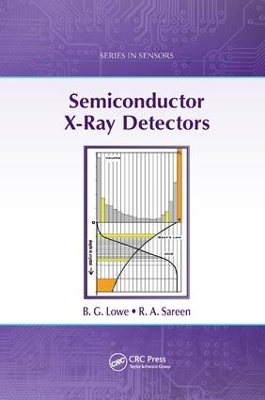
Semiconductor X-Ray Detectors
CRC Press (Verlag)
978-1-138-03385-6 (ISBN)
Semiconductor X-Ray Detectors focuses on the history and development of Si(Li) X-Ray Detectors, an important supplement to the knowledge now required to achieve full understanding of the workings of SDDs, CCDs, and Compound Semiconductor Detectors. The book provides an up-to-date review of the principles, practical applications, and state of the art of semiconductor x-ray detectors. It describes many of the facets of x-ray detection and measurement using semiconductors, from manufacture to implementation. The initial chapters present a self-contained summary of relevant background physics, materials science, and engineering aspects. Later chapters compare and contrast the assembly and physical properties of systems and materials currently employed, enabling readers to fully understand the materials and scope for applications.
Author of over 20 publications and the "conditioner" patent for Si(Li) X-Ray Detectors, B. G. Lowe holds a Ph.D from Liverpool University, UK. He has served as commonwealth education officer for University of Columbo, Sri Lanka; lecturer for University of Science-Malaysia, Penang, and North East Wales Institute of Higher Education, UK; chief physicist for Link Systems Ltd, London, UK; physics director, head of development, and senior scientist for Oxford Instruments, London, UK; and senior scientist for e2V Scientific, High Wycombe, UK. He also worked on the UK government-sponsored IMPACT project and CdZnTe detectors at Leicester University, UK. Author of over 15 publications and two patents, R. A. Sareen holds a Ph.D from Manchester University, UK. He has served as research scientist for Ortec, Oak Ridge, Tennessee, USA; founder of Nuclan Ltd, London, UK; technical, managing, main board, and executive director for Link Systems Ltd, London, UK (now Oxford Instruments) and UEI London, UK; researcher at Manchester University; and shareholder in Link Systems Ltd, Gresham Power Electronics and Gresham Scientific Instruments Ltd, Salisbury, UK, and Camscan, Cambridge, UK. A Royal Microscopical Society and Institute of Physics fellow, he has liaised with several UK government departments, including security services, and participated in nuclear strategy and homeland security committees.
Introduction
The Detector and Charge Sensitive Preamplifier: A System Overview
The Transducer
Why Semiconductors?
Fermi-Dirac Statistics
Doping of Semiconductors
The p-n Junction Barrier
Charge Generation by Radiation
Pulse Height Analysis
X-Ray Spectroscopy
Noise
Leakage Current
Typical Noise Values
The FET
Detector Response Function F(E)
Categorization of Semiconductor Detectors
The Lithium Drifted Silicon Detector (Si(Li))
The Silicon Drift Detector (SDD)
Detector Response Function
The Hypermet Function
Monte-Carlo Calculations
Physical Processes and the Analytical Approach
Peak Broadening - The Fano Factor
Charge Collection Efficiency Function
Generation of Spectral Response Function
Charge-Loss Mechanisms
Charge Gains
Detector Artifacts
Field Distortion
The Spur
Non-Linearity
Ghost Peaks
Compton Scatter
Self-Counting
Absorption Edges
Sum Peaks
Electron Contamination
Contacts
Metal
Parameters Influencing ICC
Reflection
Diffused Junction Contacts
Ion-Implanted Contacts
Surface Barrier Contacts
Low Injection Contacts
Edge Termination of Contacts
Radiation Damage
Si(Li) X-Ray Detectors
Manufacture of Si(Li) Detectors
The Legacy of Contouring
Losing the Process
HPSi and HPGe X-Ray Detectors
HPSi X-Ray Detectors
HPGe X-Ray Detectors
Performance
X-Ray Detectors Based on Silicon Lithography and Planar Technology
Silicon p-i-n Diodes
Avalanche Photo-diodes (APDs)
Pixelated X-Ray Detectors (PXDs)
CCD-Based X-Ray detectors
Introduction
Techniques of Scientific CCDs
The Performance of MOS-CCD X-Ray Detectors
The pn-CCD
CCDs Summary
Silicon Drift Detectors
Introduction
Concentric Ring SDD X-Ray Detectors
Droplet SDD X-Ray Detectors
SDD Performance
SDD Manufacture
SDD Summary
Wide Band-Gap Semiconductors
The Candidates
General Comments on WBGS
The Present Status of the WBGS X-Ray Detectors
Summary
The History of Semiconductor X-Ray Detectors
Introduction
The Beginnings
The Development of Materials during World War II
1940-1960: Crystal Counters
1940s: The Role of National Labs, Bell Telephone Labs, and other Corporations
The Story of Silicon and Germanium
Other Materials
1960-66: Progress in Detector Manufacture and Spectroscopy
Surface States and Nature's Gift of SiO2
Processing and Passivation
1960s: The Evolution of Detector Geometries
Contacts
1960s: Lithium Compensation
1960-1966: Amplifiers
1966-71: Pulsed Optical Restore
Applications on the Horizon
The Companies
1970s and 1980s: Evolution in the Commercial Environment
1970s and 1980s: Low Energy EDXMA
1987: The Kevex Quantum Window: Convenience verses Performance
High Purity Germanium and Silicon
1990s: HPGe X-Ray Detectors
1990s: Bespoke FETs
Convenience verses Performance: A New Approach
SDD: The Influence of Nuclear Physics Again
SDDs as X-Ray Detectors
The SDD EDXRS Companies
The Future
| Erscheinungsdatum | 14.05.2017 |
|---|---|
| Reihe/Serie | Series in Sensors |
| Zusatzinfo | 14 Tables b/w; 16 Illustrations, color; 343 Illustrations b/w |
| Verlagsort | London |
| Sprache | englisch |
| Maße | 159 x 235 mm |
| Gewicht | 1148 g |
| Themenwelt | Naturwissenschaften ► Physik / Astronomie ► Angewandte Physik |
| Naturwissenschaften ► Physik / Astronomie ► Astronomie / Astrophysik | |
| Technik ► Maschinenbau | |
| ISBN-10 | 1-138-03385-5 / 1138033855 |
| ISBN-13 | 978-1-138-03385-6 / 9781138033856 |
| Zustand | Neuware |
| Haben Sie eine Frage zum Produkt? |
aus dem Bereich


